#formerly enslaved
Text
Anderson Bonner

Prominent Texas landowner and businessman Anderson Bonner was born enslaved in Alabama around 1839. Not much is known about his younger years. Family history states that Bonner was given as a wedding present to the daughter of his former master, who moved him from Alabama to Arkansas. Anderson may have been “refugeed” in Texas during the Civil War when nearly 100,000 enslaved people from neighboring states were forcibly brought there by slaveholders to avoid the Union Army freeing them as it gradually occupied more of the Confederacy. If Bonner was in Texas by 1865, he—like other Lone Star state enslaved people—gained his freedom when Union General Gordon Granger and Union Troops under his command arrived in Galveston on June 19, 1865 and pronounced the end of slavery. That announcement became the basis for the Juneteenth holiday.
Sometime in 1865 Bonner married a woman known only as Eliza. Over time the couple had ten children, Anderson Jr, Newton, William, Ed, John, Andy, Mary, Martha, Charlie and Nash. Bonner arrived in Dallas, Texas, around 1870 with his brother Louis, and sister Caroline and they worked on a farm in the White Rock Creek area. Bonner by this time had acquired modest wealth. The 1870 Census lists his financial worth at $275 or approximately $5,456 in 2020 dollars. On August 10, 1874 Bonner purchased sixty acres of land, signing the deed with an “X”, as he never learned to read or write. He soon began leasing his land and the houses on it to cotton growing sharecroppers. With the money he earned, he bought more land. Bonner eventually amassed over two thousand acres of land in what is now North Dallas and the Dallas suburb of Richardson. The Medical City Dallas Hospital now sits on what was once the Bonner farm and the North Central Expressway divides Bonner’s original property.
Census records in 1900 reveal that six of the ten Bonner children still lived on the Bonner farm. Cotton, corn, and fruits were grown on the family farm worked mostly by Bonner, his children, and sharecroppers. Bonner’s sister, Caroline married into the Fields family, and one of her children married into the Giddings family, both prominent African American families of Dallas in the late 19th Century. In 1903, Eliza was killed in a oil lamp explosion in the family home. Sixty-four-year-old Bonner then married a woman named Lucinda, but the couple had no children.
Anderson Bonner passed away at the age of 82 in 1920. He was buried in White Rock Colored Union Cemetery (now White Rock Garden of Memories Cemetery), in Addison county. His descendants established the Anderson Bonner Endowment Scholarship that helps support Richardson Public School students who attend Prairie View A&M University. The first public school for black children in the North Dallas, the Vickery and Hillcrest school was renamed the Anderson Bonner School before its closing in 1955. The city of Dallas officially named the park west of Medical City Hospital, Anderson Bonner Park in 1976. The park consists of 44.1 acres of Bonner’s original land.
57 notes
·
View notes
Text
youtube
A brave new voice has emerged on the independent film scene. Meet Nazenet Habtezghi, a Black creative who’s carved out a niche for herself as a documentary filmmaker. Her latest project, where she serves as both director and producer, is “Birthing A Nation: The Resistance of Mary Gaffney” (MTV Documentary Films). It’s a story that takes the audience on an emotional rollercoaster as Habtezghi carefully unpacks the life of an enslaved woman who’s hellbent on preventing her enslavers from controlling her reproductive future. While the subject somewhat eerily mirrors some of the issues of agency that women are facing today, Habtezghi is able to keep the integrity of the era in which Mary Gaffney lived using testimonies from formally enslaved people. The film is only 19 minutes long, but each second grabs you in such a way that you’ll be thinking about Mary Gaffney many moments later.

The Brooklyn-based journalist-turned-filmmaker is a nurturing, compassionate storyteller who takes pride in disrupting the system. Habtezghi took her time to ensure she could frame Gaffney’s story in the most impactful way.
“It was important for me to say her name," said Habtezghi. “I like to say that Mary found me. I came across her testimony, and I was initially fixated on the part where she talked about chewing cotton root. I was like, ‘Are you kidding me? The thing that you’re being forced to pick on the plantation is what you’re using to control your fertility,’" said the first-time director.
Gaffney’s audaciousness in defying her slave breeders is what makes her so badass and she wasn't the only one. There were others who also chewed on the cotton root as a "natural" contraceptive, exercising control of their own reproductive futures. “I was lost in that part of her testimony. It was just so incredible."
Habtezghi was working at Firelight Films, producing, researching, and developing a different project about the Transatlantic slave trade, when she came across the archival testimonies from the Works Progress Administration (WPA), a government work release program that provided 8.5 million jobs to Americans during the Great Depression in 1935. Most of what she discovered were detailed interviews with 2,300 formerly enslaved men and women.
“After reading buried testimonies of enslaved people, enslaved women, and enslavers talking about how they raped women, I was in this emotional space,” said Habtezghi.
She later explained how a mentorship with historians Dr. Jennifer L. Morgan and Dr. Daina Ramey Berry, both of whom are featured in the film as experts on the enslaved, helped her gain a greater understanding of the relationship between Black women’s physical labor and their reproductive labor and how, when combined, it emphatically dictated and sustained slavery in America through the 19th century once the Transatlantic slave trade market was no longer an option.

“It fueled slavery and gave rise to capitalism in the United States," said Habtezghi.“Capitalism could not have existed if it wasn’t for Black women. It’s Mary’s story but it’s also the collective [story] right? It’s important to be rooted in her resistance but then become empowered by it.”
When COVID-19 happened, the project was put on pause. As luck would have it, another opportunity presented itself through Firelight Films and MTV Documentary Films. They were looking for filmmakers to create short films that could speak to the forgotten or unknown parts of Black history. Habtezghi knew exactly what story she wanted to tell. It took almost two years to bring details of Mary Gaffney’s life to light. Now, the film has been nominated for a Black Reel Award in the "Outstanding Short Film" category.
Habtezghi’s connection to this story goes even deeper. Her emotions get the best of her as she describes her personal journey as a young girl, fleeing her home in the war-stricken African nation of Eritrea and migrating to the United States. She grew up in Dallas, Texas, and would graduate with a B.A. in Journalism from Oklahoma University. In time, she landed her dream job as an editor at ESSENCE magazine.
Habtezghi has earned her bones by contributing to documentaries that have been featured on PBS, Netflix, and HBO. She co-directed The ABCs of Book Banning with esteemed documentarian Sheila Nevins for MTV Documentary Films. Nevins, who has produced hundreds of projects for HBO, is also a 32-time Emmy winner.
In her next project, Habtzghi is set to produce and direct “American Problems, Trans Solutions,” a docuseries in partnership with transgender activist Imara Jones. She has made quite an entrance in the documentary filmmaking arena with Mary Gaffney’s story, masterfully breathing life into a buried tale and giving a voice to an otherwise unknown Black woman whose secret defiance in the face of slavery deserves to be told.
#Nazenet Habtezghi Unravels the Untold Story of an Enslaved Black Woman’s Bold Decision To Control Her Own Destiny#Birthing A Nation: The Resistance of Mary Gaffney#Mary Gaffney#formerly enslaved#Black Women#Nazenet Habtezghi#Black Women Filmmakers#Youtube
8 notes
·
View notes
Text
Look I just think

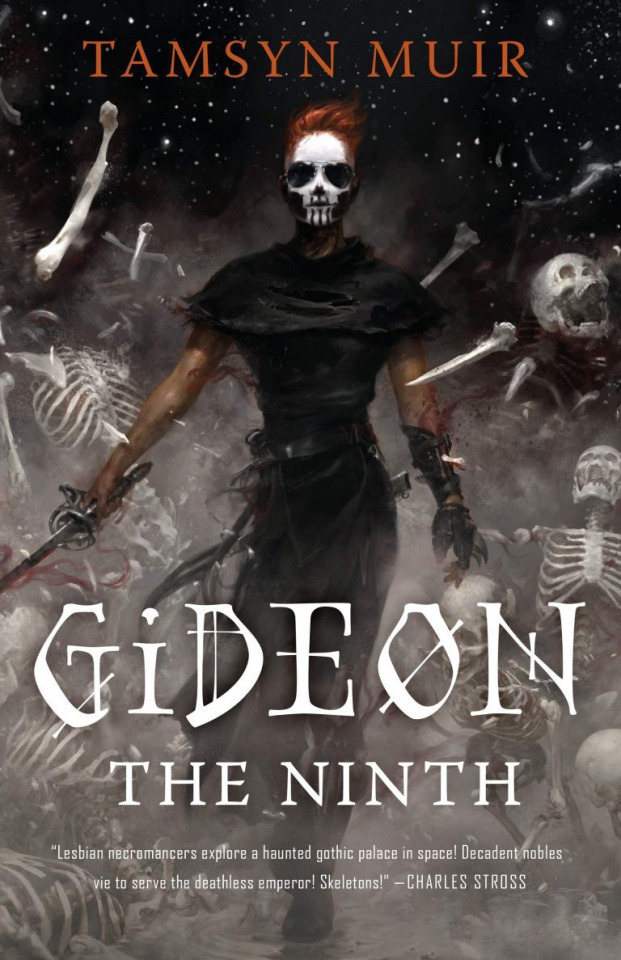

#something something red/orange mascs#something something formerly incarcerated/enslaved people who find humor in their lives#something something poor girls who work their asses off to help those around them#karlach#vi arcane#gideon nav#oops I posted this on the wrong account oh well
13 notes
·
View notes
Text




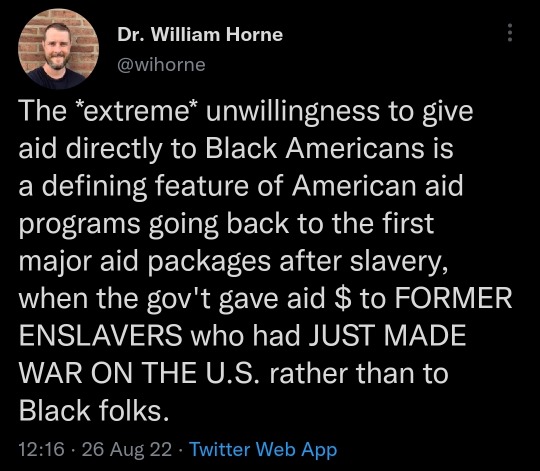

Every so often, a Black person will pose the question: "How the hell did we get the stereotype of being lazy?" And, on cue, another Black person will answer, "We stopped working for free."
51 notes
·
View notes
Text
The First Self-Proclaimed Drag Queen Was a Formerly Enslaved Man
In the late 19th century, William Dorsey Swann’s private balls attracted unwelcome attention from authorities and the press

In the late 1880s, a formerly enslaved man named William Dorsey Swann started hosting private balls known as drags, a name possibly derived from “grand rag,” an antiquated term for masquerade balls. Held in secret in Washington, D.C., these parties soon caught authorities’ attention.
As the Washington Criticreported in January 1887, police officers who raided one such gathering were surprised to encounter six Black men “dressed in elegant female attire,” including “corsets, bustles, long hose and slippers.” The following April, the Evening Starreported on a raid that targeted men in “female attire of many colors,” as well as “gaudy costumes of silk and satin.” On both occasions, authorities arrested the party guests and charged them with “being suspicious characters.”
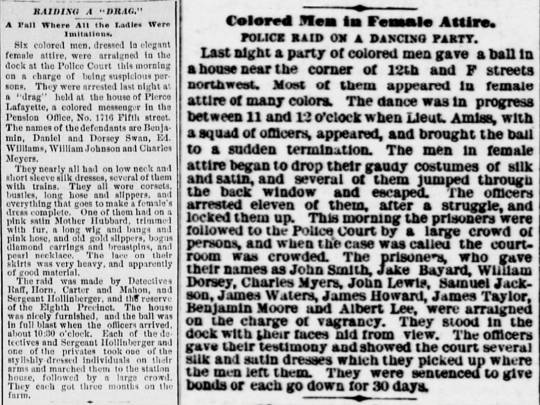
Joseph’s chance find marked the beginning of a yearslong quest to uncover Swann’s story—and, with it, the history of drag in the United States. He chronicles the results of this research in an upcoming book titled House of Swann: Where Slaves Became Queens—and Changed the World. Drawing on extensive archival research, Joseph presents a compelling portrait of the nation’s first self-proclaimed drag queen. The historian proudly positions Swann as the “first queer American hero.”
The identification of Swann as the first reported drag queen in the U.S. is a “major event,” says Jen Manion, a historian at Amherst College. “LGTBQ history is hampered by the lack of diaries and personal letters and family papers, because you just don’t put [those feelings] in writing.” For much of recorded history, Manion adds, being gay or bisexual was considered “a sin; it’s illegal.”
Joseph says his research resurfaces the “experiences of queer people, … historical experiences, not fictionalized experiences, documenting them rather than speculating.” These findings, in turn, helped him pinpoint the birth of “the drag queen.”
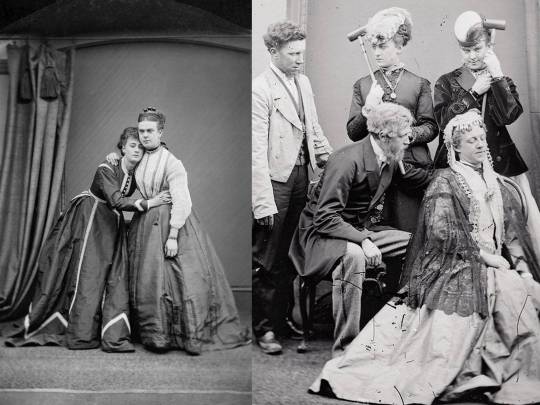
The concept of drag “existed for some period of time unknown,” says Joseph. But the term only came into use in 19th-century Great Britain, where Joseph says it referred to “a gathering of people, particularly men, who were dressing as women.” In 1871, two members of the British aristocracy were put on trial after they were caught dressing as women in public. Authorities charged Ernest “Stella” Boulton and Frederick “Fanny” Park with “conspiring and inciting persons to commit an unnatural offense.” A jury found the defendants not guilty but handed down a minor indictment to the men for wearing women’s clothing.
Cross-dressing, which is often a component of drag, has a lengthy history on both the stage and the screen, from Elizabethan-era performances in which men played women to Japanese Kabuki theater. In the early 20th century, performers like Julian Eltinge became stars by impersonating women during the vaudeville craze. In the 1950s, Milton Berle dressed as a woman on his variety TV show, as did comedian Flip Wilson in the early 1970s. In the early 1980s, the sitcom “Bosom Buddies” starred Tom Hanks and Peter Scolari as two young men who disguise themselves as women so they can live in an inexpensive, women-only apartment building.

Historian Kathleen Casey, author of The Prettiest Girl on Stage Is a Man: Race and Gender Benders in American Vaudeville, takes a much wider view of drag. While she includes all manner of cross-dressing performances in her definition, she doesn’t think there will ever be “a stable meaning of the term ‘drag.’” Casey adds, “Drag is about race, class and sexuality as much as it is about gender. If we focus exclusively on only one of these intersections, we fail to see how drag performances are layered across time and space and can have multiple meanings for different audiences.” Drag, she says, is really about a performer’s own perspective of their work, as well as audiences’ understanding of this work.
Many of the “contemporary categories and terms that we use in modern life to describe LGBTQ people or sexual and gender minorities” date to the late 19th century, says Manion. “Lesbian,” for instance, was first used in a medical journal in 1883. The historian adds, “We debate amongst ourselves as scholars when it seems appropriate to use contemporary terms to describe things [in] the past, but in this case, these were terms used by … the people at the time as well.”

Swann was born into slavery in Washington County, Maryland, around 1858. According to a 2021 entry by Joseph in the African American National Biography, Swann was the fifth of 13 children born to enslaved housekeeper Mary Jane Younker and enslaved wheat farmer and musician Andrew Jackson “Jack” Swann. (His biological father may have been a white man, but Joseph hasn’t found definitive evidence confirming this theory.) After the Civil War ended in 1865, Swann’s parents bought a plot of land and started a farm. Encouraged to work as soon as he was old enough, the young Swann found employment as a hotel waiter. In 1880, he relocated to Washington, where he worked as a janitor and sent money back home to his family.
Like Washington more broadly, the capital’s underground queer networks were divided into white and Black communities that rarely intersected. As a 2019 report prepared for the city’s Historic Preservation Office notes, “It was a hushed fact that Lafayette Square in D.C., which is adjacent to the White House, was a known cruising spot for gay men, both Black and white,” but the majority of these individuals were only interested in liaisons with partners of the same race. An exception to this trend was Washington’s drag scene, which often attracted mixed-race audiences.
Forging a place for himself in the city’s queer Black community, Swann held parties that Joseph deems the first documented “drag balls” in American history. Held in secret, they provided a safe space for gender expression but were risky to attend. “A large but undetermined number managed to flee during the police raids, but the names of those arrested and jailed were printed in the papers, where the men became targets of public scorn,” wrote Joseph for the Nation in 2020. “In post-Civil War America, there was very little patience for men who subverted gender norms.” Sentences for those charged with attending drag balls ranged from around three to ten months.

Around this same time, Swann became enthralled by the “queens of freedom” crowned at Washington’s Emancipation Day parades—annual celebrations first held in April 1866. Historically, each neighborhood was represented by a woman who “personified freedom for Black people,” according to Joseph. Inspired by these queens, Swann started crowning the winners of his dance competitions the “queen of the ball,” says Joseph.
Swann also adopted the title for himself. As the Washington Critic noted on April 13, 1888, “William Dorsey, who, by the way, was the ‘queen,’” was one of 13 people arrested during a raid on a “drag party” the previous night.
“There’s this concept of drag, which is separate, and there’s the concept of queens of freedom, and in D.C. in this particular time, post-slavery, post-Reconstruction, these two concepts collide,” says Joseph. “To identify as a drag queen, which is what William Dorsey Swann did, is combining these two strains, these two cultural traditions.”
The 1880s saw a “wave of laws passed in cities all across the country explicitly banning cross-dressing,” says Manion, who adds that the rules were “applied very selectively” and were riddled with inconsistencies and contradictions. The arrests of Swann and his friends were “even more sensationalized in the press and probably drew the attention of authorities because most of the participants were Black,” Manion explains. “And this is in Jim Crow America. For queer … Black Americans to just see so much joy and freedom in their gender expression at this time was definitely seen as a threat.”

The court sentenced Swann to 300 days in prison. After serving three months of his sentence, Swann, who had pled not guilty, filed a petition for a pardon from President Grover Cleveland, says Netisha Currie, an archives specialist at the National Archives, which houses a copy of the petition. In a show of support, 30 of Swann’s friends signed the document. But U.S. Attorney A.A. Birney argued vehemently against the pardon, stating,“The prisoner was in fact convicted of the most horrible and disgusting offenses known to the law; an offense so disgusting that it is unnamed. … His evil example in the community must have been most corrupting.”
Ultimately, Cleveland denied the petition. Still, wrote Joseph for the Nation, Swann’s unsuccessful attempt to clear his name represents the earliest documented example of an American activist taking “specific legal and political steps to defend the queer community’s right to gather without the threat of criminalization, suppression or police violence.”
As Manion says, “What’s unique about [Joseph’s] work is that it captures a collective community. When we have been able to identify queer and trans figures in this era and earlier, we find them in isolation. And we can seldom connect the dots to say, ‘Oh, these two couples were friends. They always hung out.’ … We have very little evidence of collective socializing.”

No known pictures of Swann survive. But his contributions to queer activism in Washington will soon be recognized with the redesignation of a stretch of Swann Street Northwest in his honor. The street was originally named for Thomas Swann, a former Maryland governor and Baltimore mayor who bore no relation to the drag queen.
“We have seen so much anti-trans and anti-drag legislation and rhetoric around the country in a very problematic way,” says Brooke Pinto, a D.C. Council member who introduced the bill. “In Washington, D.C., where we are proud to have so many trans residents, we [need to] speak up and recognize, sometimes through symbolism, sometimes through legislation, how important these issues are.”
The bill also calls for a historic plaque to be posted in Dupont Circle, a Washington neighborhood with a rich LGBTQ history. The plaque will sit at the corner of New Hampshire Avenue, Swann Street Northwest and 17th Street Northwest.
“One of the things that’s so exciting about this case is that it is an African American man who was formerly enslaved,” says Manion. Such individuals “just don’t get … recognition in our histories of LGBTQ people, in part because we usually can’t find them in the archives. But … Swann was hiding in plain sight.”
#swann#Drag Balls#Origins of Drag Balls#DC#LGBTQ+#The First Self-Proclaimed Drag Queen Was a Formerly Enslaved Man#William Dorsey Swann#Drag Queens#origins of drag ball culture in DC
9 notes
·
View notes
Text
Oh dear we're at the time of year where the "J*sus was a jewish palestinian anarchist" posts do the rounds
#and i get headaches#this fucking one even used a photo of a formerly enslaved man with whip scars#as 'proof it would have hurt when he whipped the ''moneylenders'''#correction#it was 'so i can personally assure you he would have maimed them for desecrating#the tumble with their commerce'#it was their own fucking temple buddy
4 notes
·
View notes
Text
just saw a tiktok that implied that the only reason lincoln allowed enslaved people to fight in the civil war was to depop the Black population...so fuck Robert Smalls and Frederick Douglass then
#I'm aware that lincoln was racist but like the reason why formerly enslaved people were allowed to serve in the army was because of the#lobbying of abolitionists to allow this to happy which more or less won the war#please ask your history professors or librarians about it
4 notes
·
View notes
Text
#american revolution#american history#Another good read.#I'm particularly struck by the 50#000 formerly enslaved people who left the colonies with the British Army at the end of the war.
0 notes
Text
thinking about reverse SVSSS AU where the demon characters are human and the human characters are demons (LBH is still both), but cultivation society operates more like MDZS so that the demon characters can preserve their ruthless clan politics and inheritance systems, and but demon society (which the formerly human characters are now part of) operates more like the ghosts in TGCF, where it's mostly a free-for-all of powerful demons establishing whatever kind of system they please in whatever space they can carve out. I think that'd preserve the meritocracy elements and "twelve different sects in a trench coat" qualities that cang qiong has as an organization.
so the peaks are instead these sort of liminal space cities which are ruled by the most powerful/influential demons, who choose their successors (at least ostensibly) based purely on talent and ability. instead of the sprawling alternate dimension demonic realms of PIDW, they're more like pocket dimensions which can only be accessed if you know the secret ways, existing in the shadows of otherwise seemingly normal towns, mountains, cities, forests, etc. humans sometimes wander into them by mistake, although whether they can get back out again or not depends a lot on which demon lord's domain they were unlucky enough to stumble upon.
Mobei Jun and Sha Hualing are still the heirs of their respective sects/clans, which are among the most powerful sects around. The CQMS peak lords are the rulers of twelve allied demon settlements. Tianlang Jun was the heir of the strongest sect, sort of like Wen Ruohan if Wen Ruohan's biggest motivation was to have his Hot Girl Summer rather than conquering everything, but after his and Zhuzhi Lang's disappearances their sect lost a lot of clout. Su Xiyan hailed from a wealthy demon phantom palace, known for its exceptional hostility towards humans (this version of HHP definitely literally eats people).
The demons-turned-humans are still exactly as cutthroat and dubious as in PIDW. Sha Hualing still wants to kill her father to take his position, Mobei Jun's uncle still tries to assassinate him, the cultivation world has an underground business in trafficking demon body parts (officially decried, but unofficially often consumed to help boost cultivation or create certain tools), the sects often go to war with one another and tend to wreak havoc on the secular human governments and societies whenever they do. All that sort of stuff.
On the humans-turned-demons end, demons in this setting are sometimes born the same way as humans -- two parents of compatible genital orientation get it on and some months later etc etc, which is how siblings like Liu Qingge and Liu Mingyan happen. But sometimes demons also just sort of manifest out of concentrated pockets of demonic energy. Some demons come from humans (SJ and YQY were both born from the unquiet ghosts of slave children), some come from animals (SQH was a pet hamster who was tormented enough to become a demon hamster, and then cultivated enough to take on a human shape), some come from collisions of powerful elemental forces such as volcanoes or floods (Su Xiyan).
So demons have a lot of apprenticeship and teacher-and-student style familial relationships, and demons looking to build families often will risk venturing out into the human realms and trying to find other isolated demons to bring into their fold. Demons alone in the human world are highly vulnerable to being hunted, killed, or enslaved. This is also why there's such a high percentage of "orphans", and contributes even more to a demon like SJ (no parents) resenting a demon like Luo Binghe (found and adopted by a kindly older demon almost right away).
So in the original PIDW, Luo Binghe is a kid who thinks he's a demon and grows up under the cruel and resentful talons of the Lord of Qing Jing, Shen Qingqiu. Every twenty or so years the demon settlements manifest much more strongly in the human realms, during which time they are a lot more vulnerable to attacks from humans. To help deal with this this, the demon rulers traditionally host big, dramatic, scary events that bring everyone within a certain geographic range together, the better to put any righteous sects off the idea of trying to single them out and attack. Most of the smaller settlements clear out entirely in preparation, leaving "ghost towns" where the buildings appear but the demons and anything too valuable to risk leaving behind are all gone.
This Demonic Alliance Conference is a time for contests, trials, matchmaking, partying, festive hunts, trading, and big displays of power. What could be a massive weakness instead becomes a big celebration, and a time for mingling and making new connections.
In PIDW, after suffering years of abuse at the hands of his cruel master, Luo Binghe attends the DAC in hopes of securing some better place for himself in demonic society. But when the righteous sects launch an unprecedented attack on the event, his human heritage is revealed, and Shen Qingqiu tosses him into the twilight space between realms in disgust. Binghe is forced to navigate the hollow and desolate place, locked into his newly-revealed and very weak human form, until he bonds with the legendary Xin Mo blade and effects his escape. Then he sets about bringing the righteous sects to heel (his bloodline means he's heir to one of the biggest sects around, even if they've fallen on hard times the past 20 or so years) and of course conquering the demon realms, and taking revenge on Shen Qingqiu, all while accumulating a record number of wives.
Shen Yuan transmigrates into Demon Lord Shen Qingqiu, ruler of Qing Jin settlement, a haunted bamboo forest in the most cursed mountain range ever.
Downsides -- he's of course destined to be dismembered and/or shoved into a pickle pot by the protagonist.
Upsides -- he's a demon with amazingly awesome demon traits! He has talons! Fangs! WINGS! Also, Binghe is a little demon bun and he is so cute, like a puppy with his fluffy wolf ears and baby claws and darling bright red eyes. Who could ever persecute such an adorable monster boy?! His tail literally wags when he's excited!
Plus Shen Yuan gets to spend as much time investigating cool beasts and other demons as he likes. He's in heaven. Well, not literally of course, but for his standards. Pretty close. Almost worth the price of admission!
#svsss#scum villain's self saving system#scum villain#bingqiu#for this I think also that heavenly demons aren't really a thing#so lbh is actually more over-powered on his human side thanks to the sect/clan system and the political weight of his bloodline
445 notes
·
View notes
Text
I think it's a shame that there was never a discworld book involving Moist Von Lipwig facing the elves. Because I would pay so much money to see that. The elves are dangerous and some of them have seriously powerful magic, but for the most part they're creatures of glamour. They entrance, trick, deceive, and intimidate. But the thing is, Moist is even better at it than they are. Moist's primary skills are just his sheer audacity and charisma. The elves are creatures of stories, and Moist knows how to spin a story better than anyone. Plus, it's mentioned elves often try to use their glamour to overwhelm humans with sheer feelings of inadequacy and inferiority. And while Moist doesn't like plenty of things about himself, he's incredibly good at hiding it. As I said, he's a man with audacity. It could also draw an interesting parallel showing how elves aren't much more than he is, just magical con-artists but at least he's trying to be better now.
Bonus: Adora Belle Dearheart vs the elves. She has an even more ironclad sense of self-confidence than Moist. Plus she has golems, which would likely be unaffected by both elf glamour and elf swords, and goblins which were formerly enslaved by the elves and are a vengeful people with access to a lot of iron. It would also be funny if they were hyper-sensitive to her cigar smoke or something
#terry pratchett#discworld#moist von lipwig#adora belle dearheart#elves discworld#elves#gnu terry pratchett#If I had the time and energy to write fanfic this would be one of the things I'd do#making money#going postal#raising steam
988 notes
·
View notes
Text
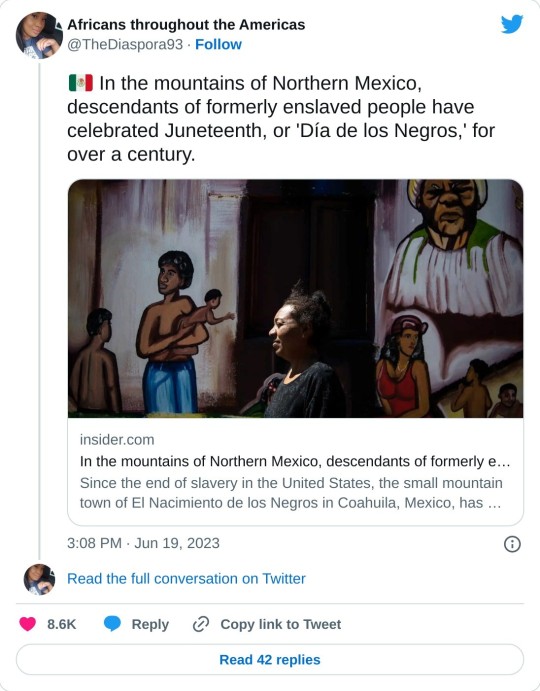

Black Seminole tribal members of El Nacimiento de los Negros have celebrated their version of Juneteenth since the 1870s.
When Mexico outlawed slavery decades before the United States, thousands of Black Texans found a new route to freedom.
Their descendants meet in Coahuila, Mexico, every year for Juneteenth celebrations.
Just over 100 miles from the Texas-Mexico border, a small mountain town in Coahuila, Mexico, is preparing for their annual Juneteenth celebrations.
El Nacimiento de los Negros, translating to "Birth of the Blacks," is home to a community of Afro-Indigenous families that trace their roots back to the United States. Known as "Mascogos," the group are descendants of Black Seminoles who found a home in Mexico after fleeing slavery and the threat of slave catchers in the US.
Black Seminoles were formerly enslaved people who escaped the plantations they worked on and aligned themselves with the Indigenous Seminoles of Florida. The joined forces with the Indigenous tribes to fight the US in the Seminole Wars.
In the 1800s, many Black Seminoles were forced to relocate from places like Georgia and Florida to areas designated Indian Territory in Oklahoma. During that time, Black Seminole chief John Horse, who had both Indigenous and Black ancestry, led a group of people to Mexico, where slavery had already been outlawed. A group settled in El Nacimiento in 1852.

The Southern Underground Railroad
When the General Congress of the United Mexican States completely outlawed slavery in 1837, enslaved people in Texas had a viable route to freedom by going southward. Notably, in the 1936-1938 federal Slave Narrative project, emancipated freeman and San Antonio-born Felix Hayward remarked: "There wasn't no reason to run up north… All we had to do was to walk, but walk south, and we'd be free as soon as we crossed the Rio Grande." By 1849, African Americans began to make the journey into Mexico.
Experts estimate that up to 10,000 people crossed the border to Mexico to secure their freedom and escape slavery, creating what is known as the Southern Underground Railroad.
Contrary to the Union's agreement to return runaway slaves under the Fugitive Slave Act of 1850, Mexican law provided freedom for escaped slaves once they touched Mexican soil. Many of those escaped enslaved people, alongside Indigenous groups of Mexico, helped defend the Northern Mexican border in exchange for acres of land in Coahuila.

Celebrating Juneteenth in Mexico
Juneteenth marks the official end of slavery on June 19th, 1865 when 250,000 Black people in Galveston, Texas were informed of their freedom by executive decree. Historians estimate that as some Black Seminoles traveled back and forth from El Nacimiento to Brackettville, Texas, Juneteenth celebrations spread to Mexico as early as the 1870s.
For more than 100 years, Mascogos in El Nacimiento have celebrated what they call "Dia de los Negros," or "Day of the Blacks," on June 19th. Many Black Seminole descendants still embark on the pilgrimage from parts of Texas to El Nacimiento to celebrate the day. Traditional cuisine includes a sweet potato bread called tetapún and slow-cooked asado pork. The dishes combine Indigenous, Black, and Mexican cultural inspirations.
After generations in northern Mexico, many members of the Black Seminoles in El Nacimiento strictly speak Spanish. However, the hymns passed down from African American descendants are still sung in English on Dia de los Negros, including "Swing Low, Sweet Chariot" and "This Little Light of Mine."
As more Black Seminole descendants are leaving El Nacimiento to find work in Texas or other parts of Mexico, many Mascogos are worried their culture is waning.

To prioritize preservation, members have established the Museo Comunitario Tribu Negros Mascogos for local art, a hotel, a restaurant, and secured federal funding for community gardens. In 2017, the governor of Coahuila declared the Mascogo tribe as Indigenous people of the northern Mexican state.
As Juneteenth was officially recognized as a US federal holiday in 2021, tribal members are planning to promote cultural tourism as a source of support and revitalization for the enduring town, and prevailing traditions, of El Nacimiento de los Negros.
#In the mountains of Northern Mexico#descendants of formerly enslaved people have celebrated Juneteenth#or 'Día de los Negros#' for over a century#mexico#Black People in Mexico#Dia de los Negros#Juneteenth in Mexico
5 notes
·
View notes
Text

Winter has started in DR Congo. With increasing cold and rain the suffering of displaced people with increase only. there is no electricity and less food and no clean water. The situation is catastrophic. Spread the world and speak up. Congolese are dying. [source: @ nyeusi_wassi on X, formerly known as Twitter. 11/27/2023.]
[Video Description: In the pouring rain and cold, there is a small, pitched tent with a few children inside under the age of ten. There are a few adults standing outside the tent area, and one woman speaking is pointing towards the children and then the camera -there is no translation available at the moment, but it appears she is highlighting the horrific conditions they are in, and how the children are especially suffering.]
For those who are unaware, there are over 6 million displaced Congolese people in the DR Congo -this is a result of the violent genocide, resource exploitation in this country for hundreds of years by western/European imperial forces, and a military coup -and the one's most impacted are young children and women. This is what we all mean by none of us are free until we all are free. That the global north governments MUST be held accountable for their complicity and contributions to the horrors and hyper-exploitation going on in the global south.
The following information, for those who are able to take some time to read some of the excerpts from this article, please do, because I do believe, researching and staying informed about what is going on this this world, especially for those of us who consume and buy products that are often created through a process of immense sufferings and enslavement of human beings in the global south, SHOULD bear witness to this, because it is the bare minimum -Free Congo:

"The bleeding of the Democratic Republic of Congo (DRC), its people, and its natural resources didn’t just start in recent months or years, but we can go as far as during the colonization days when Congo was privately owned by King Leopold II of Belgium from 1885 to 1908. Imagine having a whole country as your personal property for that many years. Congo has never recovered or healed from the bleeding that was overseen by Leopold. After taking hold of Congo, “It quickly became a brutal, exploitative regime that relied on forced labor to cultivate and trade rubber, ivory, and minerals.” (BBC News, 2020). The history of Congo, killings, and injustice are very long and still ongoing as I write this. Congolese people everywhere continue to hope, pray, and cry for peace one day and it is time that the world finally listens."
"The continuous killings and abuses of Congolese people, most of them women, and children, have been worsened by the ongoing exploitation of Congo’s natural resources."
"Children work under harsh conditions often with no pay or little pay just so big companies can profit. Women continue to be raped and used as weapons so that others can profit from the natural resources. There are also cases where children are forced to take up arms for the benefit of others all because of “The lucrative nature of cobalt mining means that all efforts to ensure production can match the eternally elastic global demand are put in."
"The east of the DRC, where the mines are located, is therefore home to nearly 40,000 child laborers digging for the minerals that would eventually be utilized by Apple, Google and other giant corporations.” (Ntreh, 2020). Some of the mining are even in the control areas of the rebel groups and yet the companies and foreign governments continue to operate as business as usual. How is this possible you might ask? Are Congolese lives worthless even after over 6 million deaths?"
"It is time that Congo’s natural resources start benefiting the prosperity of the Congolese people and the nation."
"It is time that foreign governments and companies stop interfering in Congo’s affairs and afreedding gas to the fire."
"It is time to unite and stop Congo’s bleeding once and for all. It is time to build a peaceful and prosperous Congo for the benefit of its people. Time to stop Congo’s bleeding."
[article source: "Congo is Bleeding: The Genocide & Forgotten Unrests in the Heart of Africa"]
#feminist#feminism#social justice#free congo#israel is committing genocide#congo genocide#congoisbleeding#colonial violence#colonialism#western imperialism
418 notes
·
View notes
Text

Black History Month: Did you know?
The three-light traffic signal was invented by a Black man named Garrett Morgan.
Garrett Morgan had only an elementary school education and was the son of a formerly enslaved man. Nevertheless, Morgan surmounted these difficulties and is responsible for many important inventions. Most notably, Morgan invented the three-light traffic signal in 1923.
While driving one day, Morgan witnessed a serious car crash at an intersection. This sparked his idea to add a third light to the traffic signal which would warn drivers of an impending red light. His patent was granted in 1924, and after early installments of the three-light traffic signal were successful, they spread throughout the country and became the three-light signal many of us encounter daily.
#black history matters#black excellence#black americans#black history#black history month#black tumblr#african america history#african american history
263 notes
·
View notes
Video
youtube
Think Tipping Is Out of Control? Watch This.
TWO DOLLARS AND THIRTEEN CENTS AN HOUR.
That’s how much millions of American workers are paid under the federal subminimum wage — which was set all the way back in 1991.
While many think tipping for services has gotten out of control, arguing over who deserves a tip and how much they should get distracts from what we should really be angry about: business models that depend on not paying workers a living wage.
It’s bad enough that the federal minimum wage is a measly $7.25 an hour. But employers are allowed to pay tipped workers just $2.13 an hour because supposedly the workers will be able to make up for it in tips.
Saru Jayaraman of One Fair Wage has been advocating to change this absurd and exploitative law. I asked her to share with us FOUR big reasons why we need to get rid of the subminimum wage and pay service workers a full living wage with tips on top.
Number 1: Workers who earn a subminimum wage often end up making less than the minimum wage
43 states currently allow certain workers to be paid a subminimum wage. Employers in these states are legally required to make up the difference if a worker’s combined wage and tips don’t reach the full minimum wage. But over a third of tipped workers report that their bosses regularly fail to do this.
That’s because enforcement of wage laws is lax, and it makes it easier for employers to get away with shortchanging staff.
Number 2: The subminimum wage perpetuates gender discrimination and harassment on the job
More than two-thirds of tipped workers — 70% — in the U.S. are women. And one in six women that work a tipped job are living in poverty — that’s nearly 2.5 times the rate for workers overall.
Since workers earning the subminimum wage are so dependent on tips to make a living, they are put in situations where they have to tolerate inappropriate customer behavior. A staggering 76 percent — that’s more than three-quarters of tipped workers — have reported experiencing sexual harassment on the job. And that only got worse during the pandemic.
Number 3: Tipping is actually a relic of slavery
Tipped workers are disproportionately people of color. And Black service workers in particular consistently earn less, including tips, than their white counterparts for doing the same job.
Look, this inequity of the subminimum wage is tied to America’s history of structural racism.
Following the Civil War, tipping was used as a racist solution by employers who didn’t want to pay formerly enslaved Black workers. So by allowing them to pay their workers just in tips rather than a wage, employers were able to avoid directly paying these workers.
Number 4: Paying workers a living wage plus tips is actually better for business — and our economy.
Corporate lobbyists, particularly for the restaurant industry, warn that paying workers a full minimum wage with tips on top will be devastating to businesses. But research shows these fears are completely overblown.
So far, seven states have replaced their subminimum wage for tipped workers with a higher minimum wage that still allows for tips on top. These seven states are actually faring better than the 43 states with subminimum wages for tipped workers — both in the number of restaurants and number of people employed by restaurants. And take home pay for restaurant servers and bartenders in these states was 24% higher than in states with a wage of just $2.13 an hour.
Workers at restaurants that have scrapped their subminimum wages in favor of higher minimum wages with tips on top are more productive, happier, and less likely to quit their jobs. This alone helps business owners cut employee turnover nearly in half. This is especially important following the pandemic, when restaurants are facing historic staffing shortages because over 1 million workers have left the industry due to low pay.
So not only have higher wage states been able to maintain their industries, but workers are more productive, getting paid more, and less likely to live in poverty.
And when workers have more money, they spend more money — stimulating their local economies in the process.
And for the first time in 30 years, workers are winning on this issue, like in DC and Chicago and a dozen other states.
The bottom line is that ending the subminimum wage for tipped workers is better for workers, it’s better for business, it’s better for our economy — and it’s the right thing to do.
292 notes
·
View notes
Text
Freedmen: The untold history of Indian Country slaves
youtube
#Youtube#Freedmen#Chickasaw Freedmen#Choctaw Freedmen#Citizenship in Native Tribes#Genealogy#Black Indians#Formerly enslaved to indians
1 note
·
View note
Text
Welcome To Confection Castle! (AU)

What in the World is Confection Castle? :
Confection Castle (formerly known as Candy/Candied Castle) is a role-swap AU of Pizza Tower, akin to the more well-known PT swap AU, Sugary Spire. Unlike Sugary Spire, Confection Castle only swaps the roles of the characters and not their personalities, with a few alterations. With the unchanged personalities of each character, this instead changes the mechanics, environment, and even story of Pizza Tower, with each character handling their swapped roles more differently than Sugary Spire's interpretation.
(This AU's concept was largely inspired by TS!Underswap. A reimagining and fangame of the Undertale AU, Underswap, which uses the same concept)

The Story:
Teddy is faced with the consequences of his own actions after pulling one too many pranks against a castle that was bought out by a huge confection company, Candyboy Corporations. A company that steals the competition against smaller sweets business owners. Teddy's given a warning by the corporation CEO's assistant, Granny Candydimples, that the CEO will destroy his and many other confectionary's shops, forcing them to all work for his company. Thanks to the warning, Teddy and his confectionary allies team up to take down the Confection Castle and its evil schemes.
The Characters (may or not feature some slightly outdated art):

Teddy Taffy (Theodore Taffy) - Noise in the Role of Peppino: A smug, witty, mostly down to earth, prankster who formerly premiered on the big screen before leaving it all to continue his family's legacy: making mouthwatering candy and sweets. He owns a quaint candy shop in a vaguely European town near a looming Confection Castle. He's obsessed with sugar and when he consumes a good amount of it, can become hyperactive and manic.
Suzy (Suzette) - Noisette in the Role of Gustavo: A kind-hearted, rule-following, and dorky dessert baker who owns a bakery/patisserie next to Teddy's candy shop. She's close friends with Teddy and secretly has a crush on him, which may or may not be obvious to everyone except Ted. Like Ted, her business was challenged by Candyboy Corporations, forcing her to rally against the castle with Teddy,
The Ingredipets - Role of the Toppins: Little creatures resembling confectionary ingredients that were kidnapped and enslaved by Candyboy Corp. to make the companies candy. Teddy and his allies will save each of them to defeat their competitor. Ingredipets may be different depending on the character being played.

Captain Crackle (Peppino Ravioli) - Peppino in the Role of The Noise: Captain Crackle is a well-known cereal brand pirate captain mascot for the cereal of the same name. He's played by a worn-out has-been TV and opera celebrity Peppino Ravoli who does the bidding of Candyboy Corporations to make a living. He takes on three jobs: Captain Crackle, a Candyboy Corp. gift shop worker, and the Castle's TV News Anchor. He just wants to quit everything and live a peaceful life making pizza, his real dream.
Mr. Gus (Gustavo) - Gustavo in the Role of Noisette: Mr. Gus is Captain Crackle's pirate sidekick who serves as the comic relief character, always getting the short end of the stick and being kicked/thrown around the place for comedic effect. His actor, Gustavo, has a similar story to Peppino's, working for the castle, trying to sustain a living. He owns a secret soda tavern hidden from where his boss can find it.

Mr. Lollygagger - Pizzahead in the Role of Mr. Stick: Teddy's accountant who both does and doesn't take his job seriously. He pulls many gags toward his patrons to get them to comply with his offers and tries to pose as a nice, patient, and understanding accountant who needs money in exchange for a good offer. Ted's annoyed by him, A LOT.
Sapphire - Snick in the Role of Brick: An adventurous, rule-breaking, and cocky rock candy Porcupine who loves to skate on his hoverboard at the speed of sound. He becomes friends with Suzy after pestering her rule-following morals and later helps her and Teddy's journey.

Murray Muffinman - Pepperman in the Role of Gerome: An experimental artistic genius restrained to the role of maintaining the paint job of the castle. When he's on break he goes to his supply room to unleash his creativity through all sorts of mediums. He can be found all over the castle. He will reward his own art if he is helped to find his supply room.
Gumther Gumdrop - Vigilante in the Role of The Priest: Gumther is a farmer who grows sweet-tasting fruits that grant magical healing abilities. He sells his fruits in fruit stands all over the castle but it comes with a price.

Butler Scotch - Gerome in the Role of Pepperman: Scotch is the butler of the Royal Candy Family, who were the original owners of the castle before signing an agreement with Candyboy Corp. Scotch is the first boss Teddy has to fight due to one of the Royal Candy's prince (originally intended to fight Ted) left Scotch to stand on guard as he goes out for lunch.
The Pope - The Priest in the Role of The Vigilante: The leader of the Caramelist religious group and overseer of the Basilicaramel Church. After Teddy destroys the church during one of the levels, The Pope seeks to cleanse Ted of his sins by fighting against him.

Granny Candydimples - Granny Pizza in the Role of Pizzaface: The oldest member of the Royal Candy Family who was demoted and forced to the role of the CEO's assistant. She's kind-hearted and honest with no ill intent unlike her boss, going out of her way to disobey him sometimes.
Uncle Candiesworth - Pizzaface in the Role of Granny Pizza: The Uncle of the Royal Candy Family. He's one of the few family members who rebels against Candyboy Corporations and agrees to help Teddy and his friends destroy the castle. He's grumpy, bossy, and insults people constantly, but he has a good heart.

The Teddy Doll - Role of Fake Peppino: A cursed doll resembling Teddy. It's been presumed to have been cursed with dark magic, cast on by a cult. It is unknown what the purpose of this doll was for. All we know is that you won't see it in the same place it was left at the second you turn your back towards it.
Cookie Blair - Role of Mort the Chicken: Oh boy! It's Cookie Blair from the hit 90's 3D point-and-click PC abandonware game Cookie's Bustle! Watch as she and Teddy travel across Cookie City as Ted tries to hide Cookie from the police trying to remove her entire existence for good. (To whom it may concern (looking at you), I am not profiting off this project, therefore not profiting off Cookie's Bustle. Please don't copyright strike me or this project.)
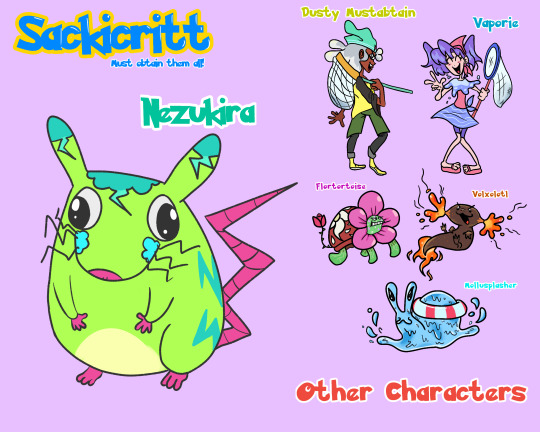
Nezukira - Brick in the Role of Snick: Nezukira is the world-famous thunder rat character from the equally famous elemental critter collecting and fighting video game "Sackicritt". Nezukira is heavily merchandised with its adorable appearance; from plushes, socks, gummies, and cigars. Besides Nezukira, there are several other Sackicritts to obtain, with "Net Handlers" who accompany them.

Jen Beam - Role of John Pillar: Jen is the older sister of Butler Scotch. She is the caretaker/ruler of all the levels in the castle, making sure that everything is in order and won't crumble to the floor. She guards the door to each "dimensional control room" that deactivates the levels in the castle. She will only let people pass if she is given gourmet candy with the finest ingredients.

Candyboy - Role of Pizzaboy: Candyboy was the prime mascot and face of Candyboy Corporations. He's a happy-go-lucky, fun-loving, eccentric kid with all the childhood innocence packed into one. He loves candy and is very marketable. Despite Candyboy's innocent presence being long gone, he is still the face of the company.
The Candyman - Role of Pizzahead: The Candyman is the man behind the whole corporation, mostly know as the CEO. Not many have had the chance to meet The Candyman in person, but he's been said to be demanding, ruthless, and manipulative to get what he wants. He will do everything to gain the title of being the best confectionary business. If it exists, he wants it in his company.
---------------------
And that's it for character introductions! I am planning on adding characters that will be entirely original in this AU like new friends that will accompany Ted, new bosses, and other characters that will build the world for this AU. Other stuff such as levels, music, and game mechanic ideas are in the works too. Lots of stuff is planned for this AU project!
If you want to make fan art for Confection Castle, go ahead! I love fan art! Just make sure to tag me if you post it. Other fan stuff like music is cool too!
Thanks for reading y'all.
(Also, I am not planning on making this an actual game as I have no experience with coding or stuff that is needed to actually make a game. But if anyone with experience with game design wants to make it happen...hit me up haha.)

#my art#pizza tower#pizza tower fanart#pizza tower au#confection castle#confection castle au#long post#the noise#peppino spaghetti#candy castle#noisette#au concept#sugary spire#sugary spire au#brick#pepperman#the vigilante#mr stick#gustavo#pizzahead#pizza tower pizzaface#pizza tower priest#gerome the janitor#john pillar#granny pizza#pizza tower toppins#pizza tower snick#teddy taffy#captain crackle#character designs might change as time goes by
294 notes
·
View notes